Chemical Analysis of Fine Particulate Matter: PM 2.5μg/m3 and PM 10μg/m3, in Cities: Prishtinë, Fushë Kosovë, and their Correlation between Pollutant Emission from TC “Kosovo”
Betim Ismajli1, Dardane Caka2, Bahrije Dobra2 and Skender Demaku2*
1Department of Information and Communication Technology, University of Pristina, Kosovo
2Department of Chemistry, University of Pristina, Kosovo
Submission: December 11, 2019; Published: December 20, 2019
*Corresponding author: Skender Demaku, Department of Chemistry, University of Pristina, Kosovo
How to cite this article: and their Correlation between Pollutant Emission from TC “Kosovo”. Int J Environ Sci Nat Res. 2019; 23(1): 556105. DOI: DOI:10.19080/IJESNR.2019.23.556105
Abstract
Kosovo is a very specific country, geographically, surrounded by all sides with the range, which is fundamentally protected, however, from the influence of the global climate, but in fact, how can this be defined when in many cases we encounter Pristina, as a city that has the primate in the world, of the day-to-day pollution of the environment, what is it that causes all this contamination, with a weak economy, why all this contamination, we have them, they are too weak filters (or have not installed them at all), then old vehicles, forest cutting, lakes contamination, above all, our awareness of a clean environment is lacking, almost `will be ours. Therefore, in this project, we will present our findings, based on chemical analysis, in the cities; Pristina, Fushe Kosovë, Obliq, the cities considered as the most polluted, therefore, the impact on the health of residents and many other environmental impacts, in the areas analyzed will bring a realistic picture of environmental pollution, a perimeter of approximately 30km, including a triangle of the three cities analyzed.
Keywords: Heavy metals, Air, Cars, Households, Thermal power plants
Introduction
The main purpose of this research will be to explain, through several key aspects, such as:
a) Expansion of scientific research with different analytical techniques and apparatus, on the content of toxic-contaminant agencies, in the troposphere (atmospheres), in the municipalities: Pristina, Fushë Kosovë and Kastriot (former Obiliq), as well as to compare the pollution of these municipalities, other regional and European cities, as well as to make comparisons to EU-WHO standards for particulate matter in the atmosphere [1,2].
b) Air quality study, through various measurement parameters of the troposphere, in the period: October-December/ 2018, analyzing collected particles in the air as composite samples for the last three months of 2018.
c) Determination of Particulate Concentration: PM: 2.5μg/m3 and PM: 10μg/m3, to examine the level of the quantity of these particles in the air, and to analyze the elements involved in these particles, namely heavy metals such as Fe , As, Cd, Co, Cr, Cu, Hg, Mn, Ni, Pb and Zn [2,3].
d) By determining the chemical analysis, realistic analysis should be carried out and appropriate measures, such as preventive measures, for the future of atmospheric polluted areas, and in general to be drawn up: analysis, conclusions and precise recommendations regarding environmental pollution [4].
In the social aspect, this research will enable us to have a more realistic picture of the air quality of these municipalities, especially in the circumscribed boundary, in the width of 15km, because good management of anthropogenic resources related to pollution the environment, will give Conclusion if the leading bodies follow up on information on the state of the troposphere air [5-6]
This research, also viewed as a challenge for environmental scientists, we think our main goal is to determine; quality, quantity and diversity of pollutants in the environment. The obtained This research, also viewed as a challenge for environmental scientists, we think our main goal is to determine; quality, quantity and diversity of pollutants in the environment. The obtained results are analyzed, compared and evaluated with allowed norms for elements according to European and World Standards (WHO, World Health Organization, respectively EU and US-EPA Directives), [7] therefore, this project represents a contribution to determining the pollutants that affect the environmental balance, and the health of people.
Material and Methods
We have set different concepts of mapping, for the measurement of solid particles-suspended matter, or other forms of concentration of different aerosols (fine particles) [8,9] as regards the concentration of these particles in the low troposphere (atmosphere), their aggregate state, and the airto- air-flow (penetration) [10,11] of these particles, in certain areas (explored) in cities, such as; Pristina, Fushe Kosove and Kastriot (formerly Obiliq), for a period of three months; October/ November/ December, 2018. With regard to methodology, methods and technical equipment, we have acted on sampling of air at intersections, and different sampling stations, where we think that the pollution has been higher, and the attendance of the living world is more dense , samples were taken, within a 3 month period, and 2 times within the month, period, October/ November/ December- 2018, i.e., in particular, the samples were taken at the entrance of cities 1 sample, 1 sample between cities, and 1 sample at the outskirts of the city, so on the same day samples were taken in the three cities mentioned above, including a sampling circuit of the explored areas. Sampling frequency is set in order to conduct a 12-week monitoring of air quality, and for a period of 3 months, where within this sampling route are also observed the possible natural impacts/ changes and anthropogenic, which have influenced the quality of tropospheric air, (especially in December), in areas designated for chemical analysis (Figure 1).

The working principle
We have operated the IBM-Casting instrument (borrowed from the “ ODA” Academy of the latter, donated by the “American Embassy in Pristina”), which is issued with start-up and its operation starts with the signal green light, is connected to the setup application on Samsung Tel, [8,9] in this case the B5 segment (based on the sales company’s name) is connected, then mounts the IBM-Casting instrument, minimum 2m high on the ground, and starts the scanning of particles: PM 2.5 μg/m3 in the atmosphere/ troposphere, so the concentration of these particles is measured in; μg/m3, for 4 to 10 seconds, through the electrochemical sensor of the device, the change of the particle penetration in the air, is fully scanned, and the concentration of these particles is placed on the screen of the Samsung phone [10-11]. After these results have been obtained, analysis and monitoring of these particles, we are sure that the measurements were successfully performed in the area investigated and the results we obtained as accurate within the sampling time. We also, as Applications (like base data), have referred to two other platforms that monitor emissions as the main pollutants of air in Kosovo, such as:
a) Pristina Air (Electroanalytic Sensor located at Arbri (former Dragodan), monitored by the American Embassy).

b) Kosovo Air Quality (Provided by the European Union), located at 8 Stations, in the most polluted cities of Kosovo (Figure 2).
Setting Static Points - Place sampling
We have used one of the techniques of using/collecting particles in the troposphere, according to the available possibilities, therefore, we have used one or more of these practical possibilities of the sampling method in the field such as: white paper, cellulose fiber, glass, synthetic material, [12,13] various cartons, porcelain-structure materials, or white metal sheets, or metal mesh structures with mesh size not larger than 10 microns and placed, in; Different shape-positions (horizontalvertical), depending on the air-pink blow of the wind (the first liked-fits the white color because it serves to better identify the different particles), but also the hardness of the static object, located at the site, to be resistant to the climatic factor.
However, its surface layer should be strong [rigid], which serves to prevent the process of absorption, or various reactions, that may occur between the collected sample and the surface layer of the object, in different places and positions (3-6, static point locations, as individual samples, [10,11] but also as composite samples, depending on the need for sampling on the field) around; 24 to 48 to 72 hours, or even longer, (all depends on the density of particles in the air of the troposphere, where the sampling, and climatic changes). The sites are monitored, and are constantly monitored on the ground, and from time to time, whatever; 2 or 3 hours, are collected-cleaned, the accumulated waste-accumulated accumulations, on the surface of the object, and placed in a sealed glass, [14,15] polyethylene bottles or capsicum shades that have been well insured , that during transport, to the place of treatment-analysis (laboratory), never have contact with the outside environment. As a monitoring point for the collection of air samples, they were; highway frequencies, highway frequencies, and static points in certain frequencies, where the largest accumulation of fine aerosol particles/ aerosols, the release of combustion gasses from vehicles from the vehicles, [15] or potential pollutants (note, to make comparisons in sampling, we used the weekend, when traffic was quieter - less dense, and when climate conditions were more favorable - without rainfall atmospheric-relative calm of winds, etc.). (US-EPA, Lammel et al., 2003, Nriagu J. O., 1989) (Figure 3).
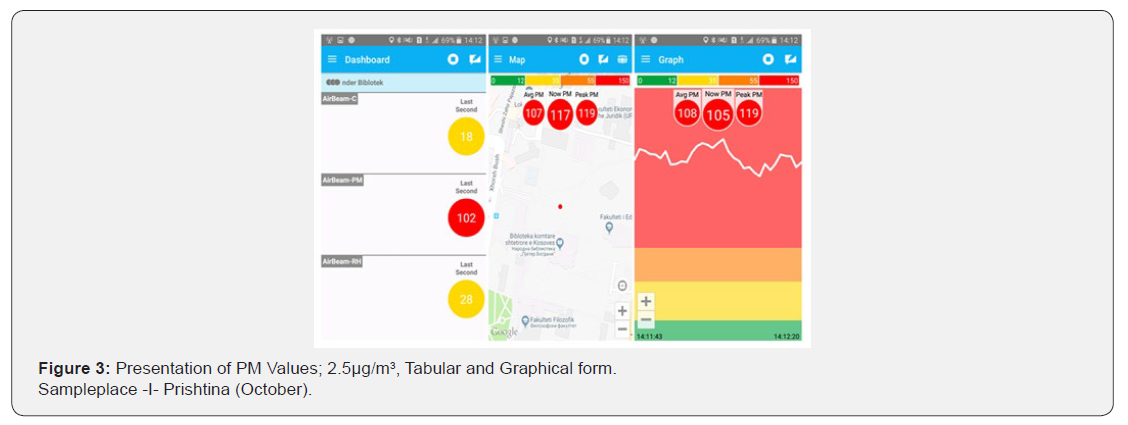
Pre-treatment of samples - preparation of samples for chemical Analysis
Aftër the samples were taken to the laboratory for chemical analysis, we first distributed the samples to the laboratory at room temperature, standing 24h, divided into four parts and homogenized in their entirety (be careful, in the room of analysis, there must be interference of air currents or samples, not put in the digester box, because the sample particles are very fine, and it is possible that the air currents, or absorption-absorption of the digester, will lose the amount of the sample, which we will use for further treatment and analysis), [16]. Then the samples were taken and placed in an electric oven at 105oC, about 24h, then weighed the homogenized sample and the weighing continued (inserting the sample back into the oven at the same temperature and each: 7-10h, weighing in continue), up to the constant weight behavior of each sample, where each sample, will now be prepared for further concrete treatment and analysis. At the moment we notice that the sample does not change during weighing in; (3 to 5 last measurements) then we will conclude that the sample is brought to constant weight (because we consider that the collected samples have come from the air together with its relative humidity, and the other additional components, which also affect the particle size, physical form and size, but also the molecular weight of these fine particles), and finally, we have begun to treat the sample according to the following procedures that we have encountered in the literature; (Technical report May 2002, US EPA 1996) (Figure 4).

Laboratory sampling - method of determination
We have taken, (weighed); 1g sample adapted for analysis, placed in a chemical cup and treated, with; 10ml HNO3 65%, which we placed on a resho, at a temperature around; 70-85oC, in the digester, which after a few starts to heat up/ evaporate (we care: during sample handling, because samples can be lightevaporated, rapidly and lose weight-weight, and occasionally , with the help of a clasp, we will remove the container from the resin to cool, and put on it a clean glass pane to maintain its mass, and the impact from the other impurities to the full blast ), also placing the glass pane over the sample container allows the most frequent contact of the vapors on the solution, which makes it even faster, the sample breakdown in its total due to the pressure of the liquid vapor, (Technical report May 2002, US EPA 1996), [17]. If the sample is not completely disassembled, (its total weighted weight), then I can also make the sample with it; 10ml HF, (because of the silicate content in the sample, and their removal during sample disintegration, through its evaporation), or additionally-treatment of royal water sample, 10ml (3HCl: 1HNO3) means the substantial breakdown of the sample. After we have found that the sample is completely dissected, then we carefully picked up the sample, filtered it and placed it in normal containers; 100ml, diluted with redistilled water, until leveling the minus sign, so that the sample after its equilibration is made ready to be analyzed by the method (s), (ICP-OES) which we are determined by earlier. (Lammel et al., 2003, Nriagu J.O) (Figure 5).
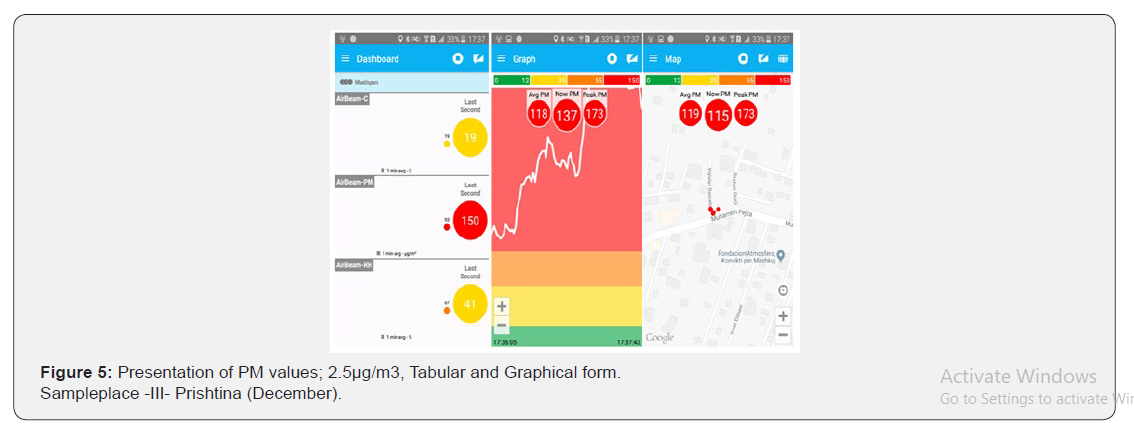
As seen from the results of IBM-Casting, which are placed on the screen of Samsung phone, and the values of results derived from the HMI web site, in almost all places, there are higher values of grime material in (EU/PM: 2.5μg/m3, maximum 25μg/m3, while for PM: 10μg/m3, maximum: 50μg/m3), [17,18] and to make comparisons, we have taken 9 sites as analytical points to compare the pollution between cities: Prishtina, Fushë Kosovë and to see the correlation with particulates released in TC “KOSOVA” [17,18], where which are monitored by MESP, (Ministry of Environment and Spatial Planning) and IHMK, (Hydrometeorological Institute of Kosovo) [18], in metering stations, which are located in nature, near potential polluting sources.
In tabular values, there is a high concentration of chemical elements in the analyzed samples, where the mercury is read less than: Hg <1ppb, whereas high values are read, ranging from cadmium to iron, in the following order : Cd> As> Co> Ni> Cr> Pb> Cu> Zn> Mn> Fe, where these values exceed any limit, compared to EU-WHO standards, or more specifically; Under Directive 2008/50 / EU (Figure 6-8).

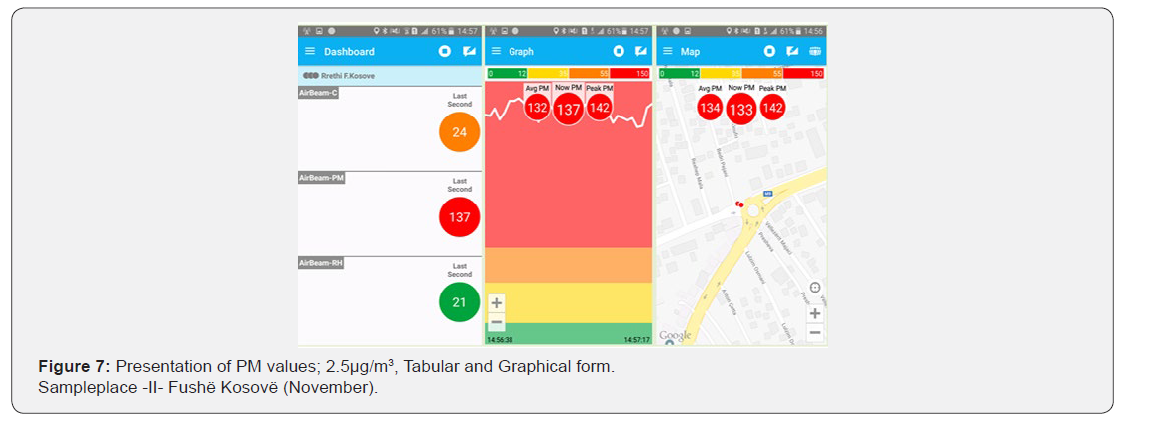
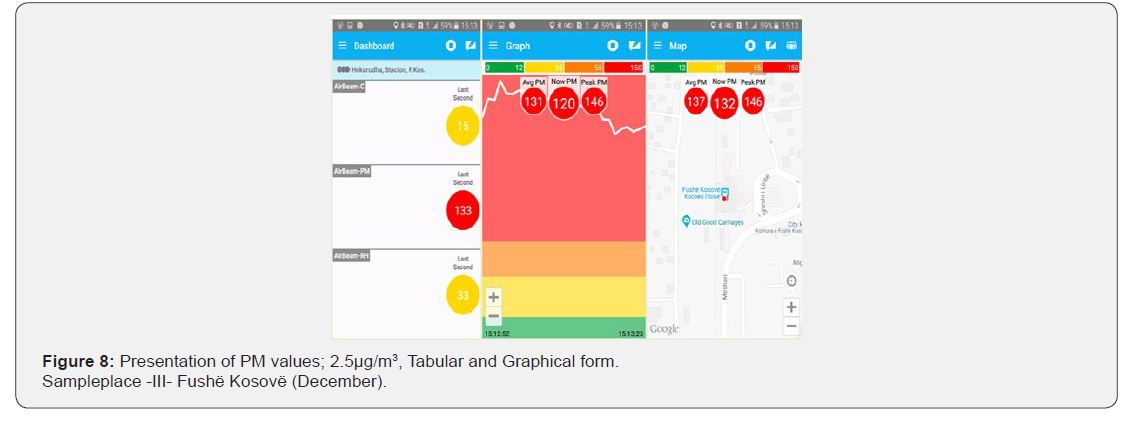
Result and Discussions
As seen from the results of IBM-Casting, which are placed on the screen of Samsung phone, and the values of results derived from the HMI web site, in almost all places, there are higher values of grime material in (EU/PM: 2.5μg/m3, maximum 25μg/ m3, while for PM: 10μg/m3, maximum: 50 μg/m3), [19-20] and to make comparisons, we have taken 9 sites as analytical points to compare the pollution between cities: Prishtina, Fushë Kosovë and to see the correlation with particulates released in TC ``KOSOVA`` [17-18], where which are monitored by MESP, (Ministry of Environment and Spatial Planning) and IHMK, (Hydrometeorological Institute of Kosovo) [18], in metering stations, which are located in nature, near potential polluting sources.
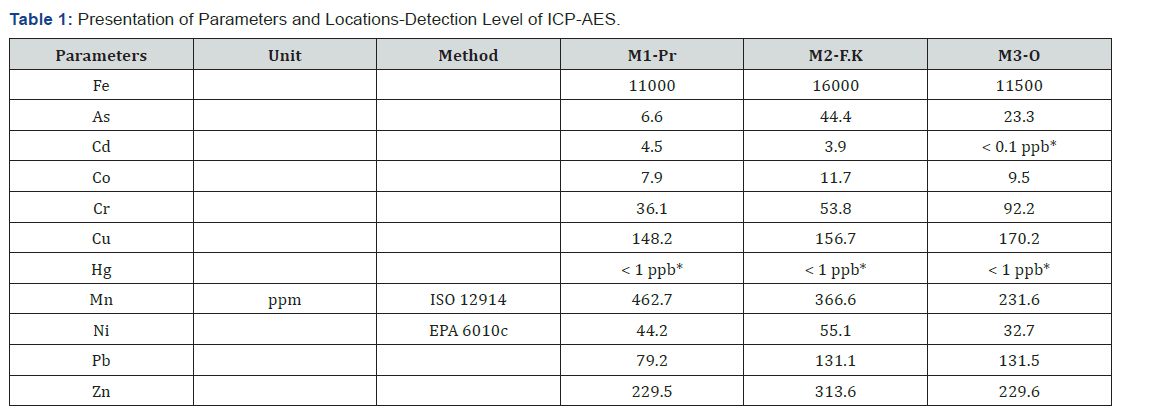
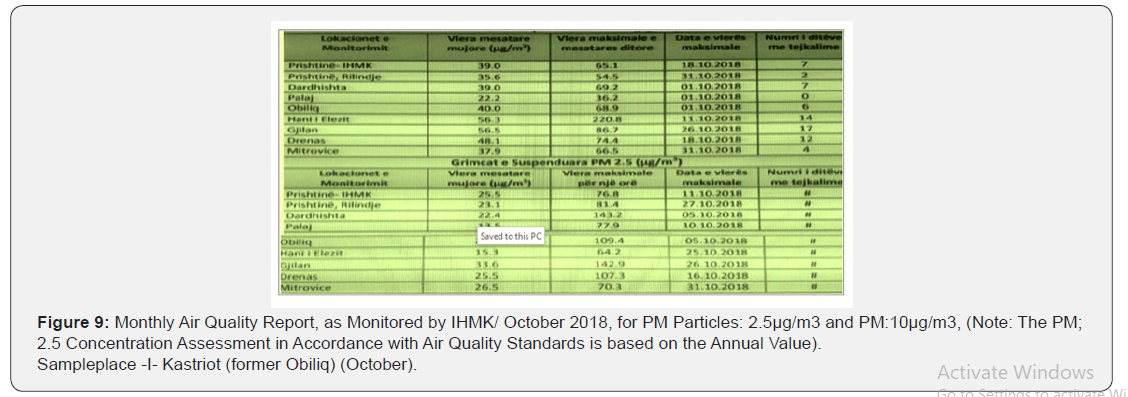
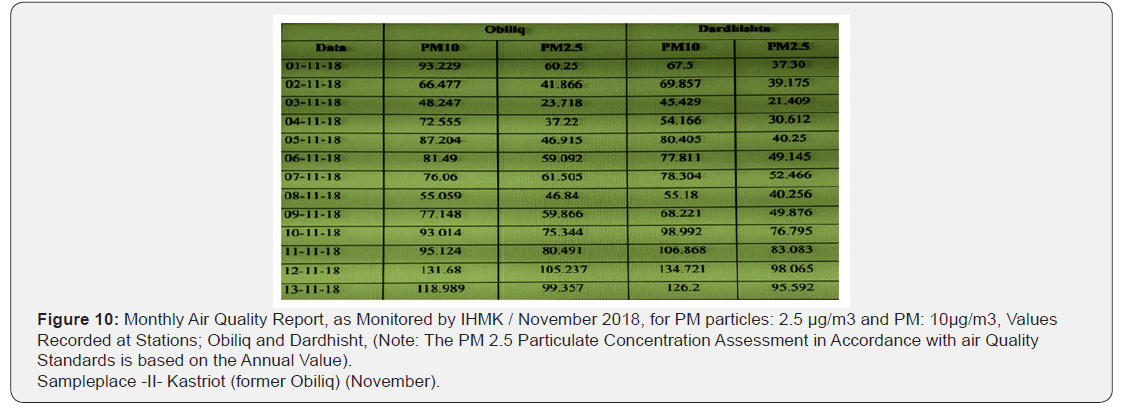
In tabular values (Table 1), there is a high concentration of chemical elements in the analyzed samples, where the mercury is read less than: Hg <1ppb, whereas high values are read, ranging from cadmium to iron, in the following order : Cd> As> Co> Ni> Cr> Pb> Cu> Zn> Mn> Fe, where these values exceed any limit, compared to EU-WHO standards, or more specifically; Under Directive 2008/50 / EU (Figure 9-12).

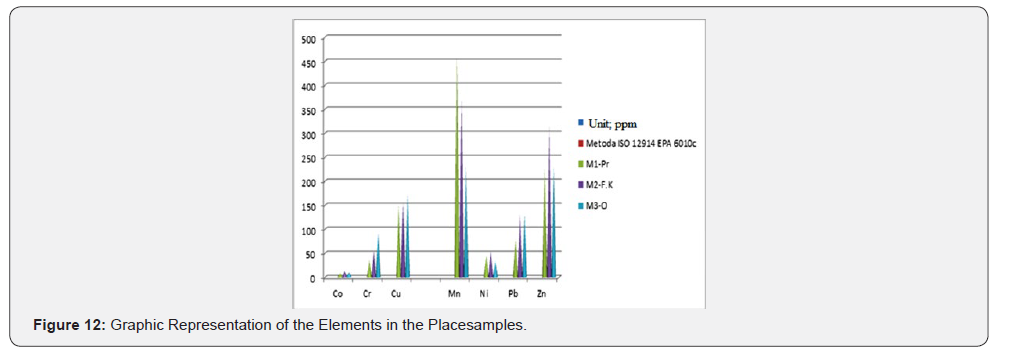
Conclusion
a) In our country, environmental pollution cases are infinite, especially in Pristina, as the capital of Kosovo, where air pollution refers to atmospheric air pollution due to the presence of several substances and gases, including; particles (PM particles with diameters 2.5 and 10 microns), aerosols - different aerosols, radicals-fragmented molecules, biological molecules, etc.
b) Air quality in cities; Prishtina, Fushë Kosovë and Kastriot (former Obiliq) is the result of a complex interaction between natural and anthropogenic environmental conditions, therefore this air pollution in the cities is a serious environmental problem, especially in developing countries where the effects of air spotted, are extremely disturbing, ranging from direct contact with humans, to the indirect impact throughout the living world, through different ways and forms.
c) The unobstructed geographic position of the city of Pristina lies in the fact that it is located at the important crossroads of motorways, motorways, railways and airways, as well as Pristina is characterized as the main center connecting the cities of Kosovo, as well as the most major cities in the Balkans, and as a result, the city of Pristina is the center of affinity for different types of pollutants.
d) The main problems of air pollution in the aforementioned cities come from; PM particles and CO2 emissions (due to thermal power plants, traffic, households, construction, etc), and when we consider our health, absorbing this polluted air, the least likely to attack the organism, where initially we have breathing problems, we continue with the high chances of heart attacks, autism, schizophrenia, to madness, so all mentioned above.
References
- (2008) Of the European Parliament and of the Council of 21 May 2008 on ambient air quality and cleaner air for Europe accessed 4 September 2015. EU, Directive 2008/50/EC, pp. 1-44.
- (2010) Kosovo Parliament - Law on Air Protection from Pollution (No. 03 / L-160). MMPH.
- (2016) Air Quality in Europe. EEA Report No 28/2016, European Environment Agency. EEA.
- Godish DC (2003) Air Quality. New York: Lewis Publishers. A CRC Press Company Boca Raton London, New York Washington.
- (2013) Strategic Environmental Assessment of Pristina Urban Development Plan 2013-2023-Pristina. Municipality of Prishtina.
- (2011) Administrative Instruction on Boundary Values-Air Quality Norms, No.02 / 2011. Goverment of Kosovo.
- Buse A, Norris D, Harmens H, Bűker P, Ashenden T, et al. (2003) Heavy metals in European Mosses 2000/2001 Survey Unece IPE Vegetation Centre for Ecology and Hydrology. Bangor, UK, p. 45.
- Bradl H (2002) Heavy Metals in the Environment: Origin, Interaction and Remediation. Academic Press, London 6.
- Chiara B, Giulia C, Francesco C, Marina D, Bert B (2018) Effects of long-term exposure to particulate matter and metal components on mortality in the Rome longitudinal study. Environment International 109: 146-154.
- (2014) Kosovo Academy of Sciences and Arts. Nexhat D. Environmental Science.
- Fernandez JA, Carballeira A (2002) Biomonitoring metal deposition in Galicia (NW Spain) with mosses: factors affecting bioconcentration. Chemosphere 46(4): 535-542.
- Allajbeu Sh, Bekteshi L, Qarri F, Lazo P, Stafilov T (2018) Spatial distribution and temporal trend of As, Cd, Hg and Pb, atmospheric deposition in Albanian. Journal of Environmental Protection and Ecology. Atmospheric Pollution 19(3): 967-977.
- Manahan ES (2000) Environmental Chemistry, Seven Editions. Boca Raton. Florida 33431.
- Fernandez JA, Ederra A, Nunez E, Martinez AJ, Infante M, et al. (2002) Biomonitoring of metal deposition in northern Spain by moss analysis. The Sci Tot Environ 300(1-3): 115-127.
- Foth HD, Ellis BG (1997) Soil fertility. (2nd edn), CRC press, Boca Raton, Florida, p. 290.
- Ford J, Landers D, Lasorsa B, Crecelius E, Martinson J (1995) Inorganic contaminants in Arctic Alaskan cosystem: long Range Atmospheric Transport or local point sources. Scien Total Envirin 160-165: 323-335.
- Godish DC (2003) Air Quality. New York: Lewis Publishers A CRC Press Company Boca Raton London New York Washington, USA.
- (2016) EEA, Air Quality in Europe-2016 report, EEA Report No 28/2016, European Environment Agency.
- Jeroen B, Maribel C, Jose BG, Marta C, Loar R, et al. (2019) Ambient air pollution and overweight and obesity in school-aged children in Barcelona, Spain. Environment International 125: 58-64.
- Castello M (2007) A Comparison between Two Moss Species Used as Transplants for Airborne Trace Element Biomonitoring in NE Italy.






























